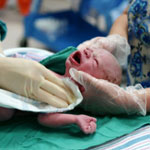Brachial Plexus Injury Subject of New Lawsuit
 A plaintiff has filed a birth injury lawsuit in Illinois, after her newborn child suffered a brachial plexus injury during the birth process. The mother plaintiff alleges the injury was due to failure of the hospital staff to properly address shoulder dystocia during the delivery. The plaintiff is now seeking damages from the hospital where the birth was performed, as well as many of the staff involved in her labor and delivery.
A plaintiff has filed a birth injury lawsuit in Illinois, after her newborn child suffered a brachial plexus injury during the birth process. The mother plaintiff alleges the injury was due to failure of the hospital staff to properly address shoulder dystocia during the delivery. The plaintiff is now seeking damages from the hospital where the birth was performed, as well as many of the staff involved in her labor and delivery.
Hospital allegedly failed to manage shoulder dystocia
The lawsuit was filed in Cook County Circuit Court on April 26, 2013. The plaintiff states in her complaint that her labor process began on May 16, 2010, and the delivery of her son occurred on May 17, 2010. The delivery was performed at Northwest Community Hospital in Illinois.
During the delivery process, the plaintiff states shoulder dystocia and a “turtle sign” were noted by hospital staff. Shoulder dystocia is a situation where the baby’s shoulder becomes stuck in the birth canal, usually behind the mother’s pubic bone. The turtle sign refers to a retraction of the fetal head immediately after delivery of the head. This occurrence signals a shoulder dystocia is present. Shoulder dystocia is a relatively uncommon complication in the delivery room, although the incidence increases in respect to the size of the fetus.
In response to those indicators, the hospital staff proceeded to attempt special delivery procedures, including a procedure known as the McRobert’s maneuver. While this technique can be effectively used to release the baby’s shoulder from behind the mother’s pubic bone, it requires a number of medical staff to complete the procedure. The plaintiff alleges there were an insufficient number of nurses present to complete this technique successfully.
The excessive use of traction by hospital staff during the McRobert’s maneuver led to the brachial plexus injury the child continues to suffer from today. A brachial plexus injury occurs when the network of nerves in the neck, known as the brachial plexus, stretch and tear during the delivery process. It is caused by undue pressure on the neck and head during childbirth and is frequently associated with shoulder dystocia. Brachial plexus injuries occur in approximately two out of every 1,000 births.
Severity of brachial plexus injury varies
The severity of the brachial plexus injury depends on the extent of damage incurred on the brachial plexus nerves. In some cases, the injury may heal on its own in time if the nerves were simply stretched and the injury was not too severe. However, when tearing occurs and the nerve damage is extensive, the injury may be permanent. These injuries may result in the child’s inability to use the affected shoulder, arm or hand.
In this complaint, the mother plaintiff states that her child’s injuries have resulted in “disability, disfigurement, physical pain and emotional suffering.” She also alleges she will be liable for medical bills and hospital expenses for her child’s injury for many years to come, since the injury is permanent. She is demanding damages from the hospital and medical staff in an amount to exceed $50,000.
- American Family Physician, Shoulder Dystocia, http://www.aafp.org/afp/2004/0401/p1707.html
- Healthline, Management of Shoulder Dystocia, http://www.healthline.com/health/pregnancy/delivery-shoulder-dystocia
- Johns Hopkins Medical, Brachial Plexus Injury, http://www.hopkinsmedicine.org/neurology_neurosurgery/specialty_areas/peripheral_nerve_surgery/conditions/brachial_plexus_injury_bpi.html

 Resources
Resources
 Resources
Resources

